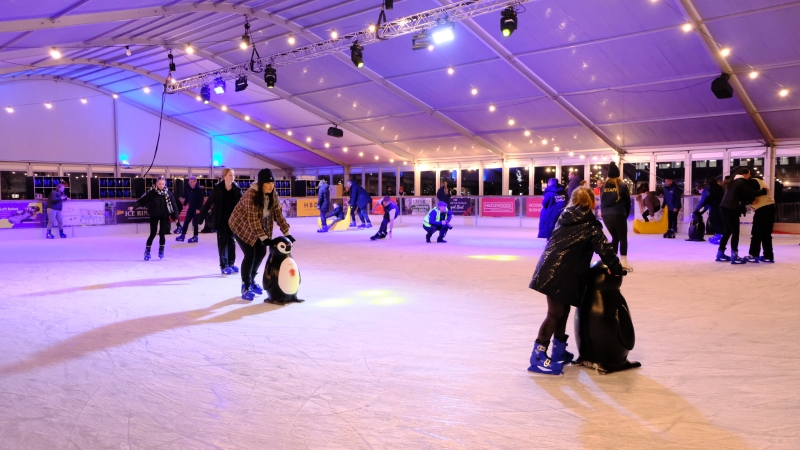Published on 18th March 2024

Visitors to the Cheltenham Christmas Ice Rink boosted the local economy by an estimated £1.6 million.
The rink in Imperial Square was enjoyed by around 30,000 people, including local families given free tickets as part of much-needed support during the cost-of-living crisis. The innovative approach to power supply meant the rink used only 12.7% of the fuel and reduced carbon dioxide equivalent emissions by 98.7%, when compared to the town’s 2021 ice rink.
Cllr Max Wilkinson, cabinet member for economic development, culture, tourism and wellbeing, said: “This council is fully committed to the environment while supporting the economy too. This is why the team have worked so hard to develop such an innovative power solution and I’m pleased to see these fantastic results. These results show that we can put on fun events while reducing our carbon footprint.”
The estimated economic impact has been identified through independent research carried out by the South West Research Company. Visitors to the ice rink spent an estimated total of £1.6 million, £860,000 of which wouldn’t have been spent in the town if the ice rink wasn’t in place. The survey also identified that around 75% of visitors came from Gloucestershire with 25% from further afield, and 83% of visitors cited the event as the main reason for their visit to Cheltenham.
The reductions in fuel used and emissions for the event are the result of an innovative power solution created by the council in partnership with KoniK based in the Quadrangle, and S3K Group, the ice rink operators. KoniK supplied a high-capacity battery which, in combination with onsite grid power, and an efficient generator, powered the chillers required to keep the ice frozen. The generator ran solely on sustainably sourced hydrotreated vegetable oil instead of traditional diesel, and the power solution was so effective that generators were only in use for a short amount of time each day. This not only contributed to the efficiencies but also minimised the noise impact of the event.
Konik’s battery has been used at many high-profile events like Glastonbury Festival, the Queen’s Jubilee and Coldplay’s world tour. Jack Wilkins, head of projects for Konik, said: “Konik was delighted to work on such a local project. It's great to be able to give back to the town that hosts our main office. Many of our employees are Cheltenham or Gloucestershire based so it has been great for the whole team to see our equipment in action and benefiting the local community so close to home.”
Hannah Ward, events manager for Cheltenham Borough Council, said: “We’d like to thank all of our partners for their contributions in achieving these results. It was important to us that we make the ice rink as sustainable as possible and, while it has not been easy to achieve this, we have laid the groundwork now and are happy that it can be used as an example for other event organisers.”
The council has been invited to share the results from the ice rink at industry forums to inspire other organisations to consider adopting similar measures to improve the environmental sustainability of their events.
For media enquiries to Cheltenham Borough Council, contact: email [email protected] telephone 01242 264231.
Attached image single use only
Notes for editors:
A copy of the Cheltenham Ice Rink Economic Impact Assessment summary is available upon request.
About the Ice Rink
Cheltenham Ice Rink was open in Imperial Gardens from Friday 17 November to Monday 1 December every day except Christmas Day. The ice rink was undercover and provided a memorable festive experience in all weathers, for skaters of all ages and abilities. The fully wheelchair-accessible ice rink offered relaxed skating sessions for SEND visitors, family discounts, and discounts for schools and group bookings, as well as dedicated student sessions and themed skates.
About the emissions
Carbon dioxide (CO2) emissions are the primary driver of global climate change. There are several less well-known greenhouse gases such as methane (CH4), nitrous oxide (N2O), and hydrofluorocarbons (HFCs). These various greenhouse gases have different global warming potentials in the atmosphere which, for ease, are converted into a single metric of carbon dioxide equivalents (CO2e). This unit of measurement has been utilised throughout the monitoring of the ice rink emissions.
- More articles in the news archive
- Cheltenham Borough Council news RSS feed